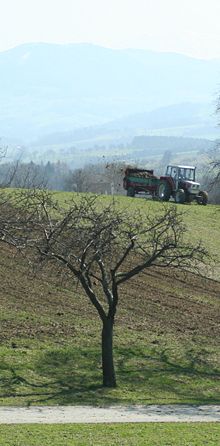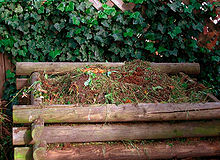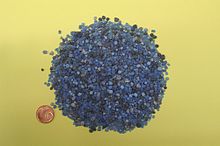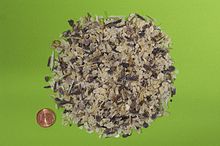Fertilizer
![]()
The title of this article is ambiguous. For other meanings, see Fertilizer (disambiguation).
Fertilizer is a collective term for pure substances and mixtures of substances that are used in agriculture, forestry, horticulture and private gardens to supplement the supply of nutrients for cultivated plants. In addition to heat, light, air and water, plants also require nutrients for their growth. These are necessary to control and support the growth and development of the plants.
The nutrients are often not present in the soil in the optimally usable form and quantity. They are displaced in the soil by leaching or are removed from it in considerable quantities by the harvested products. Only the supply of plant nutrients through fertilization makes it possible to replace these nutrient withdrawals.
Fertilization improves plant nutrition, promotes plant growth, increases yield, improves crop quality and ultimately maintains and enhances soil fertility.
The plant nutrients are needed by plants in different quantities. Therefore, a distinction is made between macronutrients (main nutrients) and micronutrients (trace nutrients).
Macronutrients include nitrogen, potassium, phosphorus (see also phosphate fertilizer), magnesium, sulfur and calcium. Depending on the nutrient, agricultural crops require about 20-350 kilograms of these per hectare in the course of their development (equivalent to grams per 10 square metres in home gardens).
Of the micronutrients are only about 5-1000 grams per hectare. This group of nutrients includes boron, chlorine, copper, iron, manganese, molybdenum, nickel and zinc. Micronutrients perform a variety of functions in plants, for example as components of enzymes, in metabolic reactions and in hormone balance. The fertilization of the plant or the soil should be adapted to the plant's needs and matched to the nutrient conditions in the soil.
Influences on plants have also been demonstrated for the following chemical elements: Aluminium, arsenic, cerium, chromium, fluorine, gallium, germanium, iodine, cobalt, lanthanum, lithium, manganese, sodium, rubidium, selenium, silicon, titanium, vanadium and others.

Fertilization with manure from the manure spreader

Application of mineral fertilisers (e.g. calcium ammonium nitrate, a nitrogen fertiliser)
Classification of fertilizers
There are various ways in which fertilisers can be distinguished or classified, for example according to origin, formation or chemical compound. Accordingly, there are many different terms used to describe fertilizers. The following groupings and explanations of terms have been drawn up (according to) these distinctions. This should contribute to a better understanding and a clearer delimitation - however, a clear assignment to these groupings is not always possible.
According to origin/creation
Starting from their original state, the raw materials are converted into a more plant-available form in various processing procedures.
Commercial fertilizer
Fertilizers sold in stores and garden centers.
Natural fertilizer
Fertilizer that is used unprocessed in the form in which it occurs. Examples are natural products such as guano, Chile saltpetre and rock flour.
Secondary raw material fertilizer
Collective term for fertilizers that are produced primarily from organic waste (biowaste) and residues, i.e. from secondary raw materials. This term covers products as diverse as composts, fermentation residue products, meat and bone meal, sewage sludge products, but also mixtures with, for example, agricultural slurry.
Farm manure
Arising on the farm. This includes manure, slurry, liquid manure, straw, digestate from biogas plants.
Synthetic fertilisers
Fertilizers that are produced with a high energy input in technical processing procedures of natural raw materials. They are offered on the market as single or multiple nutrient fertilizers.
According to the speed of their action
Fast acting fertilizers
Contain nutrients in a form that is immediately available to plants. They act immediately after application, examples: Amide, ammonium and nitrate-containing nitrogen fertilizers, water-soluble phosphates, potash salts, quicklime.
Slow acting fertilizers
The effect or availability of the nutrients occurs only after conversion in the soil. Examples: Nitrogen fertilizers prepared by plastic coating and also urea, rock phosphates, carbonic acid limes, composts, horn shavings.
According to chemical compound
Organic fertilizers
Contain organic compounds, for example from plant parts or animal excretions. A varying proportion of nutrients is bound in organic compounds. Due to their carbon content, these contribute to maintaining the humus content in the soil. In contrast to mineral fertilizers, the nutrients are contained in varying composition, plant availability and quantity. Examples: Manure, slurry, digestate, straw, compost, horn shavings.
Mineral fertilizer
They consist of mineral salts. The nutrients are bound, for example, as oxides, chlorides, sulphates, carbonates etc.. Depending on the type of fertilizer, the respective nutrients are contained in defined plant-available forms and precisely specified quantities. This means that fertilization can be precisely calculated and targeted as required (see also Precision Farming).
By number of proximity elements
Straight fertilizer
Contain only one nutrient. Thus, there are nitrogen, phosphate or potassium single fertilizers. Lime fertilizers also belong to this grouping. Small amounts of other nutrients are possible.
Complex fertilizer
Are also called complex fertilizers. They contain several nutrients in different compositions. Common examples are phosphate-potassium (PK) and nitrogen-phosphate (NP) fertilizers as dual-nutrient fertilizers; or NPK fertilizers (complete fertilizers), which contain up to five main nutrients plus trace nutrients. A distinction should also be made here between complex fertilizers of industrial production and compound fertilizers. Complex fertilizers from industrial production are marketed as branded products. Mixed fertilizers are produced in special mixing plants by agricultural traders and cooperatives. They are usually mixed from single-nutrient fertilizers.
Farm fertilizers and organic fertilizers can also be described as compound fertilizers, as they contain several nutrients.
According to the quantity required by the plant
Macronutrient fertilizer
Contain the main nutrients for plants, which are needed in large quantities. These are mainly nitrogen, phosphorus and potassium. In addition, the nutrients sulfur, magnesium and calcium; these three are sometimes referred to as secondary nutrients in the technical literature and in legislation. As a rule, macronutrient fertilizers are fertilized through the soil.
Micronutrient fertilizer
Contain trace nutrients that are needed in small quantities by the plants (e.g. zinc, manganese, boron and iron). They are applied in small quantities via the soil or via the leaf.
According to type of application
Soil Fertilizer
Are fertilized on or in the soil and thus absorbed through the roots. They are mainly used to supply macronutrients. Primarily improve nutrient substrates (soils, substrates in horticulture, soil in agriculture). The aim is, among other things, to promote growth. Examples are limes and composts.
Plant fertilizer
Are intended to be taken up directly by the plant and improve soil fertility. They contain nutrients in plant-available binding forms. These include most commercial fertilizers and also farm manures such as slurry and liquid manure.
In foliar application, nutrients dissolved in water are sprayed
onto the leaves and absorbed through the leaf, thus providing a direct effect. However, the nutrient uptake via the leaves is low, therefore foliar fertilization complements soil fertilization and is mainly used for trace nutrient supply.
FertigationThe
nutrients are applied dissolved in the irrigation water.
According to state of aggregation
Solid fertilizers
Fertiliser granules or salts
Liquid fertilizers
Fertilizer solutions and suspensions.
According to special plant groups, for special nutrient requirements and against nutrient deficiencies
- Fertilizer for foliage plants and lawn (with N-P-K fertilizer more nitrogen fertilizer)
- Fertilizer to achieve more blossoms (with N-P-K fertilizer more potassium content), for example balcony flower fertilizer
- Fertiliser for higher fruit yield (with N-P-K fertiliser more phosphate content), for example "tomato fertiliser" or (low-calcium) "soft fruit fertiliser" or fertiliser for fruit bushes
- Rhododendron fertilizer, lime-free and acidic in pH-value
- water plant fertilizer, contains little phosphates (which cause strong algae growth in the water)
- Citrus plant fertilizer, contains more easily soluble iron salts (chelates)
- hydroponics fertilizers (nitrates instead of ammonium salts, iron fertilizers with complexing agents)
- Fertilizer for conifers, mostly with sulphur (which is converted by bacteria to plant-available sulphates; see sulphur cycle), iron and more magnesium.
- Fertilizer to combat chlorosis (yellowing of leaves)
- Fertilizer for promoting the rooting of cuttings with strongly increased phosphate contents and rooting hormones

Export of slurry in a field
Types of fertilizer
Fertilisers are generally differentiated according to the way in which the fertilising substance is bound. Further distinctions are the form of the fertilizer (solid fertilizer and liquid fertilizer) and their effect (fast-acting fertilizer, long-term fertilizer, depot fertilizer). Improper use of fertilizers leads to over-fertilization (eutrophication) of adjacent areas and water bodies and thus to species decline.
Mineral fertilizer
→ Main article: Mineral fertilizer
In inorganic fertilizers or mineral fertilizers, the fertilizing components are usually in the form of salts. Mineral fertilizers are used in granular, powder or liquid form (liquid fertilizer).
Mineral fertilizers have enabled a major advance in productivity in agriculture and are used very frequently today. Some of the mostly synthetic inorganic fertilizers are problematic, for example, in view of the high energy input required for their production. In application, water solubility plays a major role. In comparison, organic fertilizers with appropriate cultivation methods lead to a higher humus content and to a higher soil quality (see humus).
Phosphates were initially supplied via the natural product guano, but are nowadays mainly obtained from mining. The decline or depletion of mineable phosphorus deposits is a sustainability problem. Phosphate ores contain heavy metals such as cadmium and uranium, which can also enter the food chain via mineral phosphate fertilizers. Every year, phosphorus fertilizers are used in German agriculture to spread, among other things, about 160 tons of uranium.
Nitrogen fertilizers are ammonium nitrate, ammonium sulfate, potassium nitrate and sodium nitrate. They are mostly produced from atmospheric nitrogen, for example via the Haber-Bosch process and Ostwald process. The production of nitrogen fertilizers is very energy-intensive: the total energy required for fertilizing with 1 tonne of nitrogen, including production, transport and application, is equivalent to the energy content of about 2 tonnes of crude oil.
Potash salts are extracted in salt mines, processed or converted to potassium sulphate. Conventional potash fertilizer production causes large quantities of waste liquor containing common salt or landfill.
Gaseous fertilizer
Fertilization with carbon dioxide (CO2) is important in greenhouse horticulture. The reason is the lack of CO2 caused by photosynthetic consumption when there is an insufficient supply of fresh air, especially in winter when ventilation is closed. Plants need carbon as a basic substance.
The carbon dioxide is either purchased as liquid gas or introduced as a combustion product from propane or natural gas (coupling of fertilization and heating). The possible increase in yield depends on how strong the lack of CO2 is and how high the light supply is for the plants.
Organic fertilizer
In organic fertilizers, the fertilizing components are mostly bound to carbon-containing compounds. If these are already partially oxidised, as in compost, for example, the fertilising minerals are adsorbed on the decomposition products (humic acids) etc.. Thus, they unfold their effect for a longer period of time and are usually washed out less quickly than mineral fertilizers. Organic fertilizers are mostly waste materials from agriculture (farm fertilizers). These include, above all, liquid manure and stable manure. However, sewage sludge is also frequently used.
A key figure for the rate of effect is the ratio between carbon and nitrogen: the C/N quotient. Organic fertilizers are usually of animal or plant origin, but can also be synthesized.
| Common contents in farm manure | |||||||
| N | P2O5 | K2O | CaO | MgO | |||
| total | effective in year 1 | ||||||
| Cow dung | kg/t | 5 | 2 | 3 | 7 | 4 | 2 |
| Pig Manure | 8 | 3 | 8 | 5 | 7 | 2 | |
| Dry chicken manure | 30 | 21 | 20 | 15 | 40 | 4 | |
| Turkey dung | 20 | 11 | 23 | 23 | 0 | 5 | |
| Chicken manure | 24 | 15 | 21 | 30 | 0 | 6 | |
| Horse manure | 4 | 2 | 3 | 11 | 0 | 1 | |
| Mushroom substrate | 9 | <1 | 9 | 14 | 27 | 3 | |
| Biogas substrate (maize/slurry) | 5 | 2 | 2 | 4 | n.n. | n.n. | |
| Biogas substrate (pellets) | 25 | 9 | 30 | 55 | 25 | 15 | |
| Fine compost (leaves and green waste) | 6 | <1 | 2 | 4 | 6 | 1 | |

Compost is more known from horticulture

Calcium ammonium nitrate

Mineral complex fertilizer with 8 % nitrogen, 8 % phosphate and 8 % potash

Horn shavings are obtained from crushed horn of slaughtered cattle.
Search within the encyclopedia